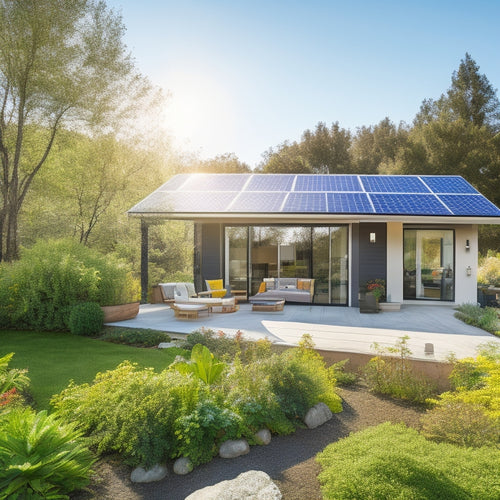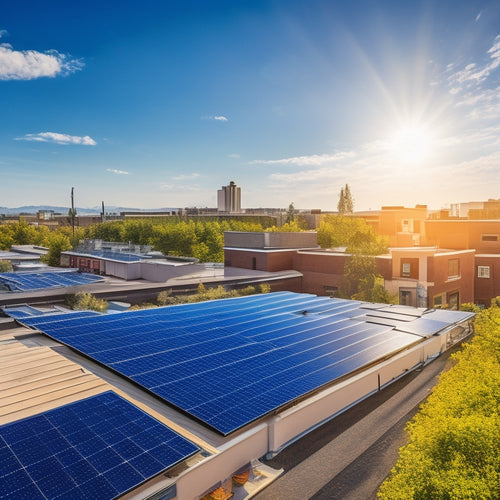
Why Do Commercial Panel Systems Cost So Much?
Share
You're likely to find that commercial panel systems come with a hefty price tag due to the convergence of advanced materials, specialized labor, complex installations, and regulatory hurdles that drive up costs. High-quality components, such as premium materials and advanced manufacturing processes, increase upfront costs. Specialized labor, intricate electrical connections, and precision quality control add to the expense. Permits, inspections, and potential roof and structural upgrades further inflate costs. Finally, integrating energy storage systems and ensuring regulatory compliance also come at a price. As you explore these factors, you'll uncover more nuances that contribute to the final cost.
Key Takeaways
• High-quality components with advanced materials and precision engineering increase upfront costs but provide long-term benefits.
• Installation labor costs are significant due to specialized training, union requirements, and intricate electrical connections.
• Permitting and inspection fees, including building, electrical, and zoning permits, add to the overall cost of the system.
• Roof and structural upgrades, necessary to support the added weight and stress, can be costly but are essential for a safe installation.
• Integration of energy storage systems, which provide backup power and reduce peak demand charges, also contributes to the overall cost of the system.
High-Quality Component Costs
When specifying commercial panel systems, you'll need to account for the costs of high-quality components. This can include advanced materials, durable finishes, and precision-engineered hardware. These premium materials and advanced manufacturing processes drive up costs, but they're essential for ensuring the system's longevity and performance.
These components, such as high-performance insulation, advanced coatings, and precision-cut frames, can noticeably increase the upfront cost. However, they will reduce energy losses, minimize maintenance, and provide a longer system lifespan. By investing in high-quality components, you'll reap long-term benefits, including reduced energy costs, lower maintenance expenses, and extended system lifespan.
Be prepared to invest in premium materials and advanced manufacturing to get the most out of your commercial panel system.
Installation Labor and Complexity
Beyond the cost of high-quality components, you'll need to factor in the significant labor expenses and complexity associated with installing commercial panel systems, which can drive up costs exponentially.
Installing these systems requires a skilled workforce with specialized training, which can be costly. Additionally, union requirements may apply, further increasing labor costs.
The complexity of the installation process also contributes to the overall expense. Commercial panel systems often involve intricate electrical connections, precise panel alignment, and meticulous quality control, all of which demand a high level of expertise.
As a result, the labor costs associated with installation can be substantial, making up a significant portion of the overall system cost.
Permitting and Inspection Fees
Obtaining necessary permits and passing inspections adds another layer of expense to your commercial panel system, as you'll need to factor in the cost of securing approvals and undergoing rigorous quality checks. This can be a time-consuming and costly process, especially when dealing with complex local regulations and municipal bureaucracy.
| Permit Type | Cost Range | Processing Time |
|---|---|---|
| Building Permit | $500-$2,000 | 2-6 weeks |
| Electrical Permit | $200-$1,000 | 1-3 weeks |
| Inspection Fee | $100-$500 | 1-2 weeks |
| Plan Review Fee | $500-$2,000 | 2-4 weeks |
| Zoning Permit | $200-$1,000 | 1-3 weeks |
Remember to budget for these expenses and factor them into your overall project cost.
Roof and Structural Upgrades
You'll likely need to invest in roof and structural upgrades to guarantee your commercial building can support the added weight and stress of the panel system, which can add significant costs to your project. Load calculations will help determine the necessary upgrades to make certain your building can handle the extra weight.
Building codes and local regulations will also influence the extent of these upgrades. For instance, you may need to reinforce your roof trusses, upgrade your roofing material, or even add support columns to assure the structural integrity of your building. These upgrades can be costly, but they're essential to guarantee a safe and successful panel system installation.
Be prepared to budget accordingly to avoid any potential risks or hazards.
Energy Storage System Integration
Incorporating an energy storage system (ESS) into your commercial panel system allows you to store excess energy generated during the day for later use, providing a potential backup power source during outages and reducing your reliance on the grid. This integration enhances grid stability by smoothing out fluctuations in energy supply and demand.
With an ESS, you'll enjoy improved power reliability, ensuring your business remains operational even during grid outages. By storing excess energy, you'll reduce your peak demand charges, leading to significant cost savings.
Moreover, an ESS enables you to participate in demand response programs, generating additional revenue streams. By integrating an ESS into your commercial panel system, you'll gain greater control over your energy usage and costs.
Frequently Asked Questions
Do Commercial Panel Systems Require Special Maintenance Schedules?
You'll need to factor in regular inspections, scheduled downtime, and maintenance frequency to guarantee peak performance, which often requires expert labor and specialized tools, adding to the overall cost of commercial panel system ownership.
Can Existing Electrical Infrastructure Support Solar Panel Systems?
'Can your electrical infrastructure handle the power surge? You'll need to evaluate your grid capacity to make sure it can support the added load. Power upgrades might be necessary to avoid electrical overloads.'
Are There Tax Incentives for Commercial Solar Panel Installations?
You'll benefit from Federal Credits, which can cover up to 30% of your commercial solar panel installation costs, and State Rebates, which vary by location, offering additional savings on your investment.
How Do Weather Conditions Affect Commercial Solar Panel Efficiency?
As you navigate the nuances of commercial solar panels, you'll find that sweltering summers and harsh winters wreak havoc on efficiency, with climate extremes and seasonal variations having a substantial impact on energy output, making precise system design essential.
Can Commercial Solar Panels Be Installed on Flat Roofs?
You'll need to verify that your flat roof can support the weight of commercial solar panels, taking into account roof obstacles like vents and skylights, and evaluating structural integrity to guarantee a safe and efficient installation.
Related Posts
-

Green Home Improvements Using Solar Power
Investing in solar power alters your home into a sustainable haven while slashing energy costs. You can greatly reduc...
-

How to Reduce Home Energy Bills
To reduce your home energy bills, start by investing in energy-efficient appliances and upgrading your insulation. Lo...
-

Solar Energy Solutions for Small Businesses
Switching to solar energy can be a game changer for your small business. You'll enjoy significant cost savings on mon...


